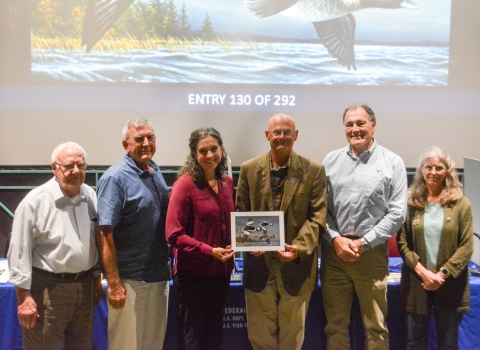The U.S. Fish and Wildlife Service is announcing the opening of a public comment period for a proposed programmatic Candidate Conservation Agreement with Assurances (CCAA) for the Texas kangaroo rat. The 10-year agreement with the Texas Parks and Wildlife Department would involve private landowners with ranching and farming operations to address the conservation needs of the species in North-Central Texas.
“This is a collaborative, voluntary agreement that was developed with our state partner and input from private landowners,” said Amy Lueders, the Service’s Southwest Regional Director. “This innovative agreement will allow us to achieve the goal of conserving an imperiled species while providing regulatory certainty to the agricultural and agritourism industry in the Texas kangaroo rat’s historical range. We encourage the public to review the draft agreement and associated documents and submit comments by the deadline.”
A CCAA is a formal, voluntary agreement between the Service and non-federal landowners to conserve habitat that benefits at-risk species. In return, participating property owners receive assurances that no additional conservation measures will be required if the covered species is listed as threatened or endangered under the Endangered Species Act (ESA).
The Service provides these assurances through an “enhancement of survival” permit, giving authorization to participating landowners for take that is incidental to conservation and ongoing activities covered by the CCAA. Take includes harming or killing a listed species and is prohibited under the ESA unless a permit is issued.
Under the Texas kangaroo rat CCAA, private landowners with livestock and farming operations within the historical range of the species would carry out measures to maintain and enhance existing habitat or populations of the species and support the establishment of additional populations. These conservation measures include prescribed grazing, prescribed fire, range planting and reseeding, maintaining dirt road edges, and conserving prairie dog colonies.
The Texas kangaroo rat is a small brown mammal with a white belly, named for its hopping style of locomotion that resembles that of a kangaroo. The proposed CCAA covers the historical range of the species in Texas in all or portions of 11 counties: Archer, Baylor, Childress, Clay, Cottle, Foard, Hardeman, Montague, Motley, Wichita and Wilbarger.
Texas kangaroo rats are declining in numbers due to multiple factors, including habitat loss. The Service is assessing the status of this species and will soon determine whether it warrants a proposed listing under the ESA.
A notice of availability for the proposed CCAA will publish in the Federal Register on Feb. 22, 2022. This will open a public comment period regarding the “enhancement of survival” permit application associated with this proposed conservation agreement. Please submit comments by March 31, 2022.
To view the draft NEPA document and CCAA, visit: https://www.fws.gov/media/texas-kangaroo-rat-draft-ccaa-and-nepa-documents.
Written comments may be submitted by one of the following methods:
- Electronically: Submit electronic comments to arles@fws.gov.
- By hard copy: Debra T. Bills, Arlington Ecological Services Field Office 2005 Northeast Green Oaks Boulevard, Suite 140, Arlington, Texas 76006, Texas; telephone 817-277-1100 ext 22113; fax 817-277-1129.
The Service’s priority is to make implementation of the ESA less complex, less contentious and more effective. We seek to accelerate recovery of threatened and endangered species across the nation, while making it easier for people to coexist with these species. We work to proactively conserve habitats for declining species through voluntary tools like CCAAs and the Partners for Fish and Wildlife program. To learn more about the Endangered Species Program, visit http://www.fws.gov/endangered/.
Frequently Asked Questions:
Q. What action is the U.S. Fish and Wildlife Service (Service) proposing?
A. The Service is announcing the availability of an enhancement of survival (EOS) permit application from the Texas Parks & Wildlife Department (TPWD) for the Texas kangaroo rat. The application includes a Candidate Conservation Agreement with Assurances (CCAA) for species conservation, which covers livestock and farming operations within the historical range in Texas.
The CCAA and associated EOS permit, if approved, would be in effect for 10 years and would provide private landowners an ability to provide voluntary conservation for the candidate Texas kangaroo rat. It would further provide incidental take coverage for implementation of the conservation strategy and conservation measures, and ongoing and continuing agricultural activities.
The Service is also announcing the availability of a draft screening form that has been prepared to evaluate the permit application in accordance with the requirements of the National Environmental Policy Act. The Service is seeking public comment on the application and draft NEPA screening form supporting a Categorical Exclusion through March 24, 2022.
Q. What is a Candidate Conservation Agreement with Assurances (CCAAs)?
A. CCAAs are voluntary agreements that provide non-federal landowners, industry, local government and others the opportunity to implement conservation practices that address specific threats and receive an assurance that, if the species is listed, they can continue to manage their land and waters as outlined in their agreements with no additional requirements. If a species is listed and a CCAA is in place, those entities enrolled in the CCAA will not be required to do more than they have agreed to do under the agreements.
Q. How would the CCAA benefit the Texas kangaroo rat?
A. CCAAs are intended to reduce or remove identified threats to a species. For the Texas kangaroo rat, the CCAA and associated permit would implement a voluntary conservation strategy for the species developed by TPWD in coordination with the U.S. Fish and Wildlife Service, Arlington, Texas Field Office. The conservation strategy includes conservation measures to minimize and avoid direct and indirect impacts to the Texas kangaroo rat and its habitat that an enrolled landowner would implement, while TPWD would coordinate a comprehensive monitoring and adaptive management program, and research and development of habitat requirements specific to the Texas kangaroo rat to inform future adaptive management and habitat creation. The expected result of the implementation of the conservation strategy and conservation measures is a net conservation benefit to the Texas kangaroo rat as the agreement is focused on activities that restore, maintain, and enhance habitat for the species, which would be considered in a future listing decision.
Q. If the draft CCAA is approved, how does the Service plan to monitor implementation of the CCAA?
A. The CCAA includes a management and monitoring schedule. The TPWD will meet with the Service at least once a year, and provide annual reports that include a discussion about activities that occurred under the CCAA, along with the status of populations in the 11 Texas counties where the species may occur. The Service will work closely with TPWD as they implement the CCAA.
Q. If the draft CCAA is approved, will it preclude the need to list the Texas kangaroo rat?
A. CCAAs are effective because they encourage voluntary participation from users of the land and water whose operations would most likely be affected if the covered species were to be listed for protection under the Endangered Species Act. The idea is that if proper conservation measures are being voluntarily implemented prior to a listing; increased regulation protecting the species might be unnecessary. The most significant benefit of the CCAA is that it will guide conservation actions that improve the status of this species and its habitat within the 11-county Texas range. However, the Service cannot guarantee that participation in these agreements will prevent the listing of any species.
Q. Where is this species found?
A. The Texas kangaroo rat occurs in Wichita, Wilbarger, Hardeman, Cottle, and Childress counties, Texas. The 11-county Texas range of CCAA coverage includes the historical counties of Montague, Clay, Archer, Baylor, Foard, and Motley counties. Texas kangaroo rats are threatened by habitat fragmentation due to conversion of native rangeland to cropland and woody encroachment. The species is believed extirpated from historical sites in Cotton and Comanche County, Oklahoma.
Q. Are there other conservation efforts that are being implemented for the Texas kangaroo rat?
A. Yes. The Service and several of our partners are funding research that will expand our understanding of the species’ needs and inform conservation efforts. The Service’s Partners for Fish and Wildlife Program, as well as the TPWD, are working with private landowners interested in prairie habitat restoration and enhancement.
Q. How do I provide comments the draft CCAA and low-effect screening form?
A. Regarding any of the documents available for review, you may submit written comments by one of the following methods. In your comments, please reference Texas kangaroo rat CCAA.
Electronically: Submit electronic comments to arles@fws.gov.
By hard copy: Debra T. Bills, Arlington Ecological Services Field Office 2005 Northeast Green Oaks Boulevard, Suite 140, Arlington, Texas 76006, Texas; telephone 817-277-1100 ext 22113; fax 817-277-1129.
We request that you send comments by only one of the methods described above.



